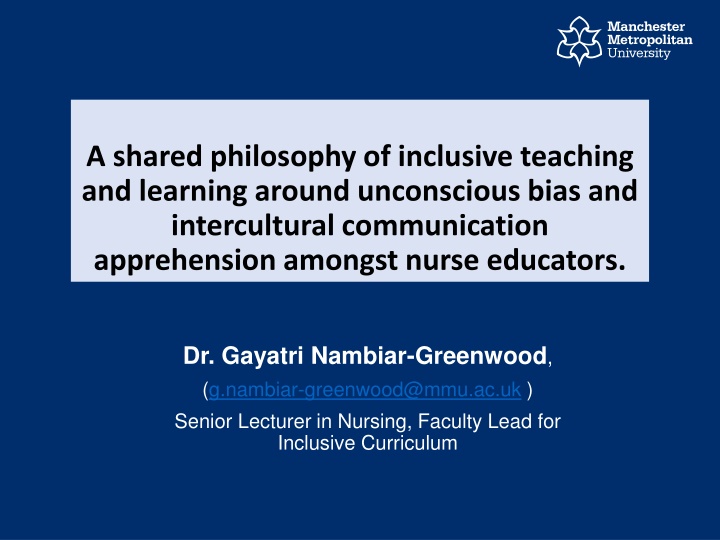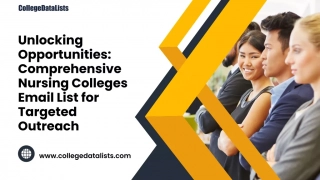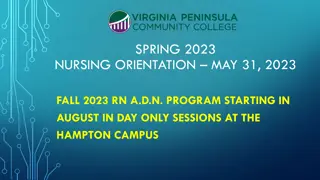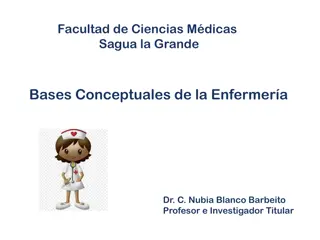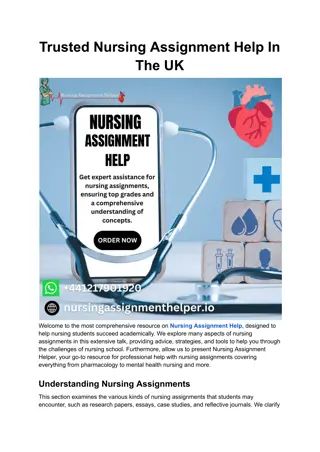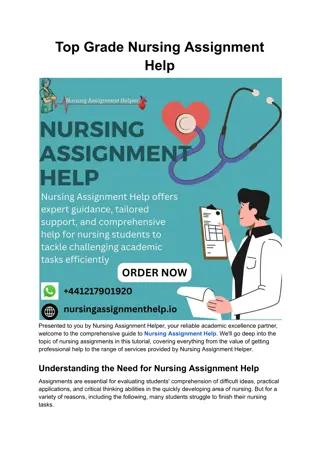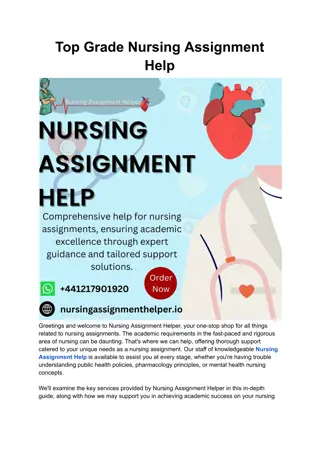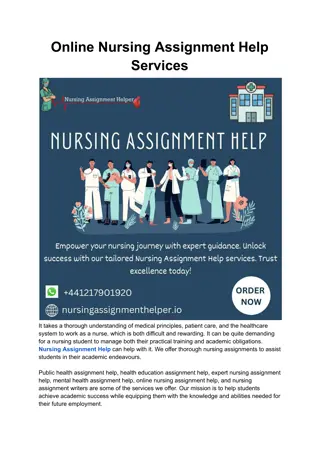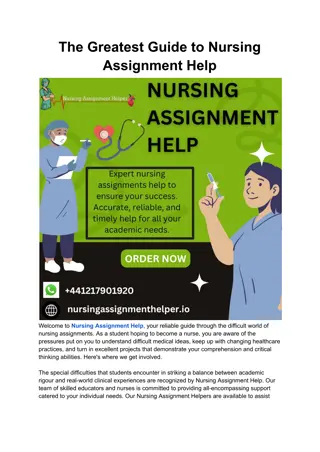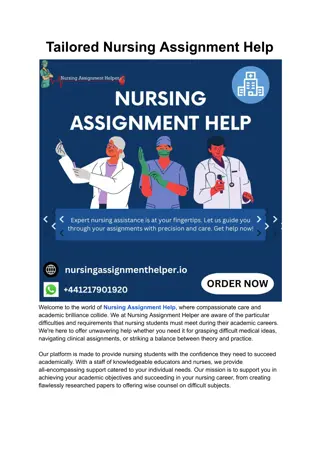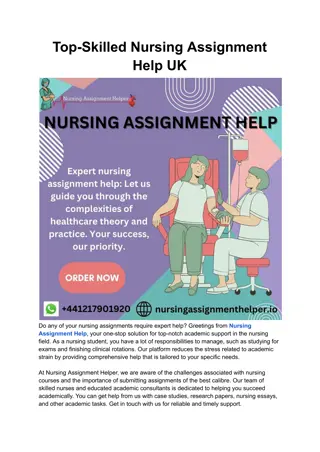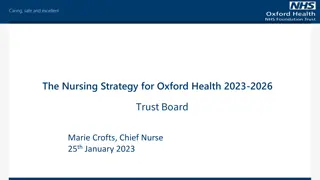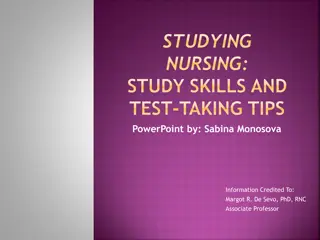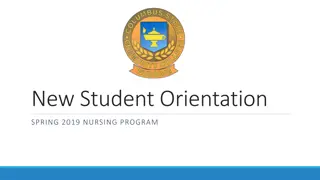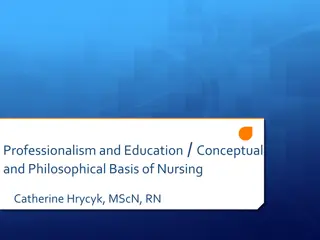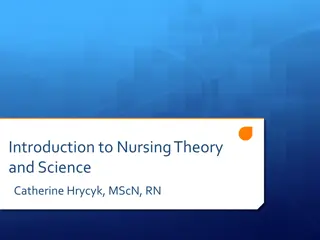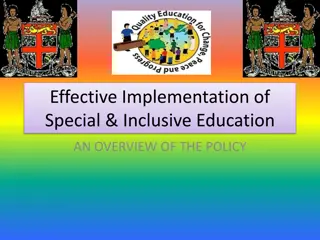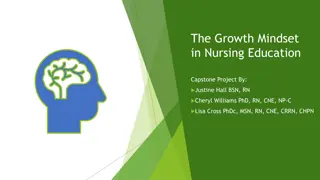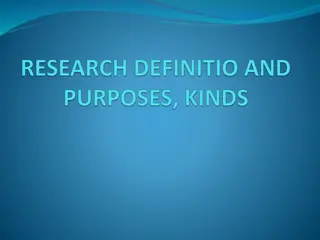Cultivating Inclusive Teaching in Nursing Education
Discussions on inclusive teaching in nursing education, focusing on unconscious bias and intercultural communication apprehension amongst educators. Dr. Gayatri Nambiar-Greenwood leads a team approach to develop a fair and compassionate curriculum. The study aims to enhance cultural awareness and reduce biases, with findings emphasizing the importance of preconceptions in understanding different cultural perspectives.
Download Presentation

Please find below an Image/Link to download the presentation.
The content on the website is provided AS IS for your information and personal use only. It may not be sold, licensed, or shared on other websites without obtaining consent from the author.If you encounter any issues during the download, it is possible that the publisher has removed the file from their server.
You are allowed to download the files provided on this website for personal or commercial use, subject to the condition that they are used lawfully. All files are the property of their respective owners.
The content on the website is provided AS IS for your information and personal use only. It may not be sold, licensed, or shared on other websites without obtaining consent from the author.
E N D
Presentation Transcript
A shared philosophy of inclusive teaching and learning around unconscious bias and intercultural communication apprehension amongst nurse educators. Dr. Gayatri Nambiar-Greenwood, (g.nambiar-greenwood@mmu.ac.uk ) Senior Lecturer in Nursing, Faculty Lead for Inclusive Curriculum
Background/Context Discussions around culture influenced by politics, mass media and history focus on: differences in ethnicity, faith groups and migrants/ Cultural other Cultures of the majority population/lack of homogeneity is ignored/ Ethnocentricity Research in nursing and cross-cultural psychology: Papadopoulos (2018)/ Ramsden (2003)/ Ting-Toomey (2012)/Wrench (2006) Etic/Emic outlook on cultural care/ Intercultural communication apprehension and defensiveness
Goals of study To engender a shared team approach in developing an inclusive, fair and compassionate curriculum that is for purpose in this globalised age Hermeneutic approach, allowing for the generation of new ideas, unexpected emergences and newer assumptions. Simple thematic analysis
The plan Cultural Awareness day : introduce, engage and improve cultural self-awareness, reducing unconscious bias and ethnocentricities 2 of these 2-day study days were planned to ensure that all members of the team are able to attend. Out of 40 staff, 12 attended. Went from essential to attend if you want Post exercise interviews: 8 interviews
Findings: Pre-conceptions Important in understanding and comprehending this within a hermeneutic approach. The Participant Information Sheet / Terms such as culture and multiculturalism /Societally, anxious feelings of intercultural communication apprehension or intergroup anxiety (Neuliep, 2017) remain apparent as these subjects are manipulated by politics and media (Bradshaw and Howard, 2017) to win support. Zimmerman (2015) unconsciously would have considered its reasons and meanings within their own worldview. Even for those who may have misconstrued the connotation or justification of this project, within hermeneutics, clarification of misunderstanding allows for a newer kind of understanding regarding the subject. This may have influenced thoughts of participants in considering discussions around personal unconscious bias and ethnocentricity in a public forum /refusals
Findings: Mode of delivery of project Combination of presentations (with an accompanying PowerPoint presentation), handbook, discussions and exercises: all participants who took part in the interviews afterwards were positive about the experience. All participants felt both days had been facilitated well. Three of the seven participants interviewed commented positively on the flipped classroom nature of some discussions. This method has the potential to engage learners in ways that addresses the contextual and complex needs that are being addressed at that point (Betihavas et al., 2015) and allow for spaces for thinking out arguments, troublesome knowledge and clarification. All participants expressed gratitude for being allowed to voice their views in a non-judgemental environment. One participant in particular stated it was an effective way of tackling a politically sensitive subject.
Findings: Content Findings: Content of seminar Participants found the global approach of culture, beyond ethnicity, race and religion, useful, thought provoking and unusual. A safe space to accept unconscious bias as natural and not linked to personal racism was also welcomed. This generated conversations around the role of politics and media in perpetuating stereotypes and grouping large sections of society together (e.g. White, Black and Asians). Examples of intergenerational socialisation, around how we see others and ethnocentric ideas over the decades perpetuated much laughter. Shared realisation of the effect of political and media based rhetoric that originally shock and then become normalised in our everyday language, which Shiner and Winstock (2015) refer to as the negotiation of moral ambivalence / Normalisation of micro- aggressions
Findings: Content of seminar Nearly all the participants felt that the project had influenced a re-thinking about language and examples used when teaching. Wider range of examples to explain culture, cultural practices and conversations around equity and equality. Reducing white normativity of teaching Three participants, especially in relation to the understanding ethnocentricity and intercultural communication apprehension, mentioned the phrase gained useful insight concerning their learning. Other phrases used were very relevant , broadens my perspective and thought-provoking . Two participants felt that this type of training should be mandatory, across the University. Another two participants felt the need for this type of workshop to happen within nursing practice. One participant, refused to be interviewed, expressed was interesting but did not agree with the content (a lack of agreement to discussion around the political and media s manipulation of immigration numbers)
DISCUSSION DISCUSSION Challenges of self-awareness in relation to unconscious bias and ethnocentricity Engaging in self-awareness can be a troublesome exercise for anyone: it requires people to be honest about previous errors, their ethnocentricities and personally held prejudices.(Meyer and Land, 1999/2003) Nurses or educators with a lack of self-awareness about their own ethnocentric views or paternalistic attitudes can immediately pass judgement on the behaviours of others without any thought to the contextual situation (Fiarman, 2006). The belief that by just working in a multi-ethnic environment can develop the affective constructs such as cultural sensitivity, competence and desire will fail to manifest, if the management support nor conversations for such an environment is absent (Reimer- Kirkham, 2000). Challenge of elegant challenging (Thompson, 1998) versus strong challenge of continuing discriminatory behaviours (DiAngelo, 2018 and Eddo-Lodge, 2018)
DISCUSSION DISCUSSION Challenging the language and discussions of unconscious bias and ethnocentricity The language, examples and literature chosen by nurse educators to discuss culture and examples of behaviours, habits and practices must expand to include a wider range people and challenge the white normativity of nursing and health care (Bell, 2021) Prevalent construction of subjects around culture remain limited (e.g. multi, inter, cross) in its position to those who are culturally other must be challenged. Differences in a whole range of cultures that cut across majority and minority groups or identities such as youth cultures, urban or rural cultures. Regards differences within LGBTQIA cultures or people with disability or the role of intersectionality and income, in favour of race, ethnic or religion based cultures. Challenge discourse, bound by stereotypical homogeneity and conversations such as All African-Caribbean people (fill in the blanks with preferred group) are sustained, instead of being transformative. Fiarman (2016: 11), there is a need to eliminate the stigma around talking about our bias . Normalising dialogues about bias, through direct teaching, demonstrating and overtly identifying it, can increase awareness. This allows nurse lecturers to discuss and examine their own biases more freely and effectively.
Limitations? Limited the number of people attended. Some staff expressed that they would not and did not need to attend a course on unconscious bias, as they felt this was not part of their behaviour. For some people any efforts to promote diversity is inherently uncomfortable and becomes labelled as a merely politically correct or woke action. Meyer and Land s (2005) threshold concepts: the developing of self- awareness regarding unconscious bias and ethnocentricity remains a process of self-discovery that is not always pleasant and agreeable but it seems irreversible.
NOW WHAT? NOW WHAT? Past 10 months: new leadership/new staff/move forward/revisit training. BLM/ Decolonising agenda More training, this has deemed to be successful Book and Movie Club (across the faculty) Top down and Down up initiatives My role as the EDI department lead: Engage team in a range of activities and research that will promote discussion, teaching and learning scholarship around UCB, awarding gap issues(change of language), racism, hearing the student voiced on the subject etc, publishing.
References Ahmed, S. (2007). You end up doing the document rather than doing the doing : diversity, race equality and the politics of documentation , Ethnic and Racial Studies, 30, pp. 590 609. Austgard, K. (2012). Doing it the Gadamerian way using philosophical hermeneutics as a methodological approach in nursing science. Scandinavian Journal of Caring Sciences, 26(4), 829-834. Banaji, M.R. & Greenwald, A.G. (2013). Blindspot: Hidden biases of good people. New York, NY: Delacorte Press. Bell, B. (2021). White dominance in nursing education: A target for anti racist efforts. Nursing Inquiry, 28(1), e12379. Besley, T. & Peters, M. A. (2011). Interculturalism, ethnocentrism and dialogue. Policy Futures in Education. 9 (1). https://doi.org/10.2304%2Fpfie.2011.9.1.1 Bellack, J.P. (2015). Unconscious Bias: An Obstacle to Cultural Competence. Journal of Nursing Education. 54(9):S63-S64. https://doi.org/10.3928/01484834-20150814-
References Cook-Sather, Alison. "Respecting voices: how the co-creation of teaching and learning can support academic staff, underrepresented students, and equitable practices." Higher Education (2019): 1-17. DiAngelo, R. (2018). White fragility: Why it's so hard for white people to talk about racism. Beacon Press. Douglas, H., & LeeShell, C. (2014). Building Advocacy in Healthcare: The Impact of Intergroup Dialogue on the Cultural Sensibility Outcomes of Health Profession Students Using an Individual Diversity Development Framework. Online Theses and Dissertations.275. https://encompass.eku.edu/etd/275 Drakulich, K. (2015). Explicit and Hidden Racial Bias in the Framing of Social Problems. Social Problems, 62(3), 391-418. Retrieved from https://www.jstor.org/stable/26370856 Eddo-Lodge, R. (2018). Why I'm no longer talking to white people about race. Bloomsbury Publishing. Fiarman, S. E. (2016). Unconscious bias: When good intentions aren t enough. Educational Leadership, 74(3), 10-15.
References Neuliep, J. W. (2017). Intercultural communication: A contextual approach. Sage Publications. Papadopoulos, I. (Ed.). (2006). Transcultural health and social care: development of culturally competent practitioners. Elsevier Health Sciences. Perkins, D. (2006). Constructivism and troublesome knowledge. Overcoming barriers to student understanding: Threshold concepts and troublesome knowledge, 1, 33-47. Pettigrew, T. F., & Tropp, L. R. (2006). A meta-analytic test of intergroup contact theory. Journal of Personality and Social Psychology, 90(5), 751 783, Papastergiadis, N. (2018). The turbulence of migration: Globalization, deterritorialization and hybridity. John Wiley & Sons. Meyer, J., & Land, R. (2003). Threshold concepts and troublesome knowledge: Linkages to ways of thinking and practising within the
